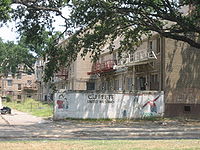- Magnolia Projects
-
The Magnolia Projects, officially the C.J. Peete Projects, was one of the Housing Projects of New Orleans. As part of the ongoing redevelopment, the area has been renamed Harmony Oaks[1]. The project was among the largest, housing approximately 2,100 people. It is (in)famous nationwide for both its legendary violent-crime rates, as well as spawning a number of world-famous Hip Hop artists. Located in the part of Uptown New Orleans known as Central City, it was bounded by Louisiana Avenue, South Claiborne Avenue, La Salle Street and Washington Avenue. The Magnolia Projects are located within the 11th and 12th Wards of New Orleans. At its height, the Magnolia projects had 1403 units.
Contents
History
The first part of the project was constructed in 1941, bordered by Louisiana Avenue, Magnolia Street, Washington Avenue and LaSalle Street. In 1955, the complex was expanded north past Clara Street, incorporating about six additional city blocks.
Toledano Street was re-aligned during the 1955 expansion, resulting in the disappearance of a three block long residential street named Belmont Place. The only remnants of Belmont Place today are three houses facing Toledano before it joins with Louisiana Avenue.
During the Jim Crow laws era of racial segregation, the city's main medical care facility for African-Americans, Flint Goodridge Hospital, was on the southwest end of the Magnolia on Louisiana Avenue. The first three African American mayors of New Orleans were born at Flint Goodridge.
From 1952 through 1978, the manager was Cleveland Joseph Peete. In the 1980s and 1990s conditions in the projects declined severely. In 1998 demolition of portions of the projects began as part of a Housing Authority of New Orleans (HANO) revitalization plan. There are plans to redevelop the area along the lines of what had been done with the St. Thomas Projects.
By 2005, only the 1955 expansion had been razed. The majority of the remaining buildings were vacant and fenced off, with only a portion still occupied, when the area flooded in the aftermath of Hurricane Katrina (see: Effects of Hurricane Katrina in New Orleans). Redevelopment work has been delayed in the aftermath of the disastrous flood which devastated the majority of the city.
As of late 2008, the Magnolia Projects had been vacated and the majority of buildings razed.
On January 7, 2009, local, state, federal and HUD officials met to break ground on a new $183 million C.J. Peete community meant to replace the Magnolia Projects.[2] The plans include 460 units, a Recovery School District school and YMCA in the first phase. 2/3 of the community will be mixed-use and mixed-income, with the rest being market value apartments and town homes.
Crime problems
It was one of the more notoriously dangerous housing districts in the United States. The Magnolia Projects had the highest murder rate of any housing project in the city, even more than the Melph and the Calliope. This section of New Orleans had a local crime rate higher than many full municipalities in the United States and has had a significant influence in New Orleans' extremely high murder rate.
Cultural contributions
The various New Orleans housing projects are most notable for being the launching ground for Bounce Music and New Orleans Rap. The most well-known artists to come out of the Magnolia Projects are Juvenile and Turk of the Hot Boys, a former rap group who started their careers on Cash Money Records. The label shot to fame in the late 1990s and still is popular today. Other popular artists from the area include Soulja Slim, Ruda Real, Jay Electronica and Mr. Marcelo.
The district is often referred to as Magnolia or Nolia. The Magnolia has been the scene of Juvenile's hit song "Nolia Clap", a dance inspired solely by the Magnolia Projects. The Magnolia Projects has also been home to sculptor Willie Birch. The park on La Salle in the Projects, A.L. Davis Park, has long been a frequent site of brass band parades, and an important gathering site for Mardi Gras Indians tribes. Under the old name of "Shakespere Park" (originally commemorating New Orleans mayor Joseph A. Shakspeare) it is mentioned in the lyrics of Professor Longhair and Papa Celestin.
References
- ^ "C.J. Peete redevelopment gets name". New Orleans CityBusiness. 10 September 2009. http://www.neworleanscitybusiness.com/UpToTheMinute.cfm?recID=26728. Retrieved 12 September 2009.[dead link]
- ^ http://www.wwltv.com/topstories/stories/wwl010709cbcjpeete.1a0a49c.html
External links
Public Housing in New Orleans B.W. Cooper (Calliope) | Desire (Abundance) | Fischer | Florida | Guste (Melpomene) | Iberville | Lafitte | C.J. Peete (Magnolia) | St. Bernard | St. Thomas (River Garden)

Housing Authority of New Orleans Categories:- Neighborhoods in New Orleans, Louisiana
- Public housing in New Orleans, Louisiana
- Uptown New Orleans
Wikimedia Foundation. 2010.

